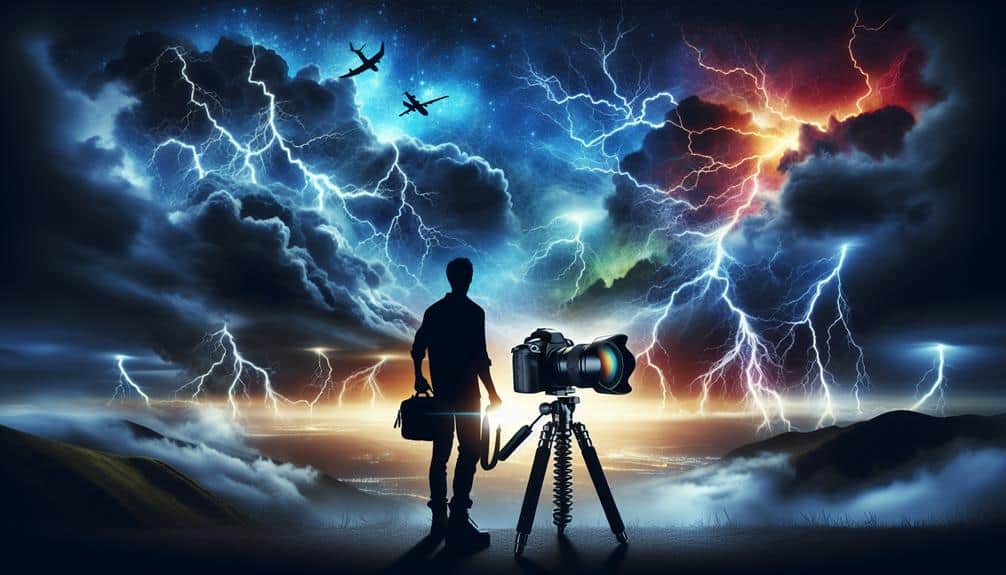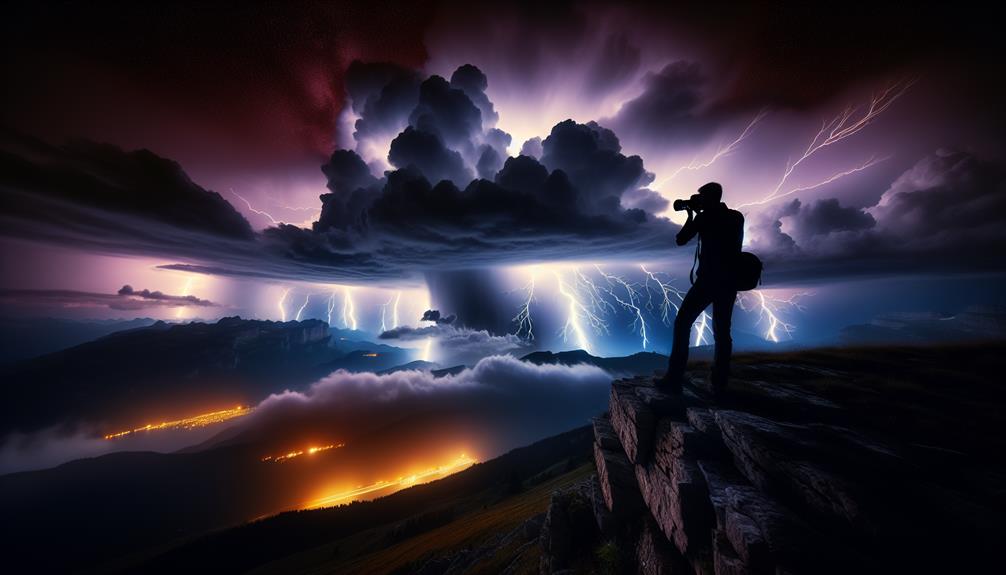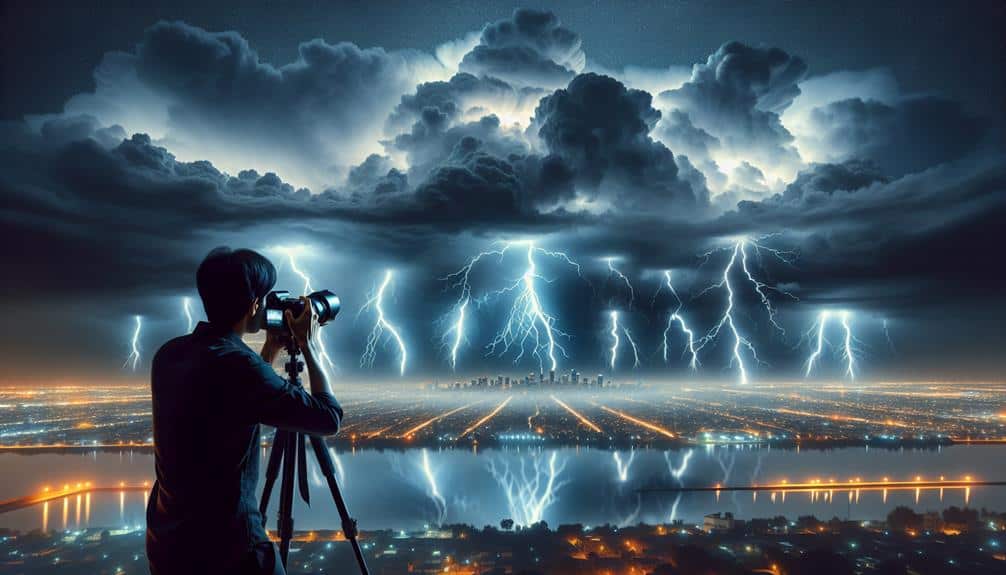When photographing lightning strikes, safety is essential because lightning can carry up to one billion volts and reach temperatures of 30,000 Kelvin. We face high risks of electrical shock and damage to sensitive electronics. Employing weather apps and lightning detection systems helps predict storm movement, while using non-conductive tripods and remote triggers reduces risk. Additionally, it's vital to maintain a safe distance of at least 10 kilometers from storm activity. Flame-resistant clothing and insulating gloves offer protection. By prioritizing these safety measures, we mitigate risks while capturing impressive images. Let's explore further to master safe lightning photography techniques.
Key Points
- Lightning strikes can reach up to one billion volts, posing a severe risk of electrical shock.
- Electromagnetic pulses from lightning can damage sensitive electronic equipment.
- Elevated areas and metal objects significantly increase the risk of being struck by lightning.
- Proper protective gear, including flame-resistant clothing and insulating gloves, is essential for safety.
Understanding Lightning Risks
When photographing lightning strikes, we must understand the significant risks involved, including the high probability of electrical shock and potential equipment damage. Conducting a thorough risk assessment is essential.
Lightning photography isn't just about capturing stunning images; it's about balancing our desire for freedom with the inherent dangers of storm chasing.
Risk assessment starts with understanding the electrical nature of lightning. Each lightning strike carries up to one billion volts of electricity and can reach temperatures of 30,000 Kelvin. Given these extreme conditions, the probability of electrical shock is high if we're too close. Equipment damage is another concern; sensitive electronics are particularly vulnerable to electromagnetic pulses generated by lightning.
To mitigate these risks, we must implement stringent safety precautions. Using a tripod with non-conductive legs reduces the risk of electrical conduction. Additionally, remote triggers allow us to operate cameras from a safe distance.
Storm chasing should always involve monitoring real-time weather data and having an escape plan. Apps like RadarScope provide precise storm tracking, enabling us to stay informed and maintain a safe distance.
Choosing Safe Locations
Selecting safe locations for photographing lightning demands a detailed analysis of geographical features, weather patterns, and potential hazards. We need to prioritize our safety while making sure we capture the most stunning images.
For lightning photography in urban areas, selecting elevated positions that provide clear, unobstructed views is vital. Rooftops or tall buildings can be ideal, but we must verify they've proper lightning rods and are structurally sound. Using weather apps and lightning tracking tools can assist us in predicting storm paths and avoiding risky areas.
When engaging in mountain photography, we must exercise heightened caution. Mountains are naturally attractive for lightning but also present significant risks. Safe spots include lower elevations, away from ridgelines and isolated trees. It's imperative to maintain a safe distance from metal objects, such as fences and guardrails, as these can conduct lightning strikes. Real-time weather data and topographical maps are invaluable for identifying the safest vantage points.
Using Protective Gear
Equipping ourselves with appropriate protective gear is essential to mitigate the risks associated with photographing lightning. Protective clothing and equipment serve as our first line of defense against potential hazards. Lightning can generate temperatures of up to 50,000 degrees Fahrenheit and release currents exceeding 30,000 amperes. Hence, ensuring that we wear flame-resistant clothing can greatly reduce the risk of burns.
Additionally, we must prioritize the use of safety goggles. These prevent debris or intense light from damaging our eyes, as lightning strikes can create blinding flashes and propel particulates at high velocities.
Wearing gloves, particularly those made from insulating materials, can minimize the risk of electrical conduction, providing an additional safety buffer when handling metal camera equipment.
Moreover, it's vital that our protective gear is both certified and tested to withstand extreme conditions. For instance, gloves should comply with standards like ASTM D120, which certifies their effectiveness against electrical hazards.
Monitoring Weather Conditions
Accurate monitoring of weather conditions is crucial for safely photographing lightning strikes. We must depend on advanced lightning detection systems to track storm activity. These systems utilize sensors and satellites, providing real-time data on lightning strikes' proximity and frequency.
The National Lightning Detection Network (NLDN) reports over 25 million lightning strikes annually in the U.S., underscoring the significance of our vigilance.
Weather alerts play a pivotal role in our safety strategy. Alerts from the National Weather Service (NWS) offer timely updates on severe weather conditions, enabling us to make informed decisions. By subscribing to these alerts, we can receive notifications about thunderstorms' development, intensity, and trajectory.
This real-time information empowers us to select the safest locations for setting up our shots while steering clear of imminent danger.
We should also incorporate mobile applications that provide precise radar imagery and lightning strike maps. Apps like My Lightning Tracker and RadarScope offer detailed data on storm cells and lightning activity.
Setting Up Equipment Properly
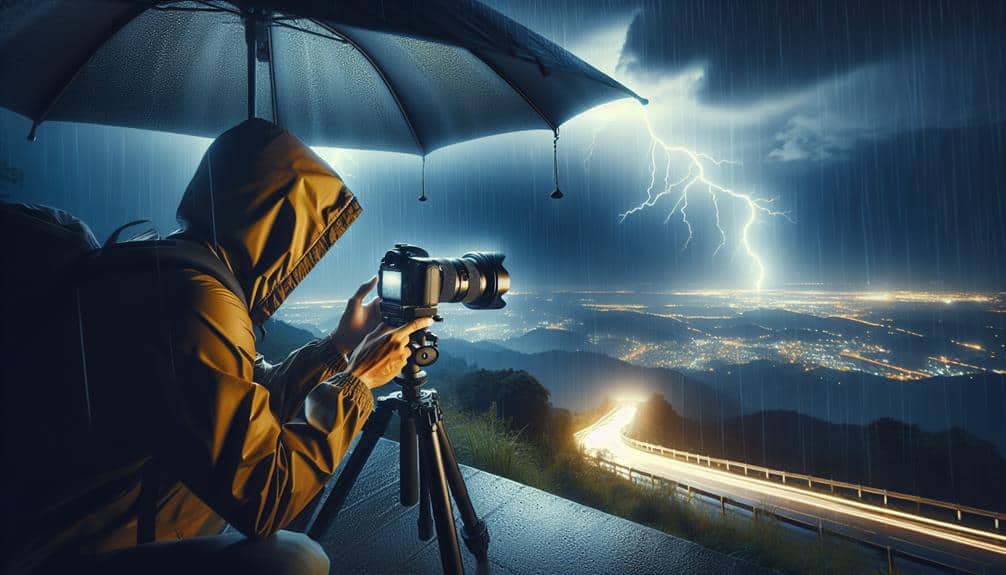
To capture lightning effectively, we must prioritize location and stability, ensuring our vantage point is both safe and unobstructed.
Utilizing weatherproof gear is essential to protect our equipment from adverse conditions, which can damage sensitive components.
Additionally, setting up a sturdy tripod and using a remote shutter release minimizes camera shake, allowing for precise exposure control during unpredictable lightning events.
Location and Stability
Selecting a perfect location and maximizing equipment steadiness are critical steps for capturing high-quality lightning photographs. First, we must carefully evaluate equipment positioning and terrain considerations. Choosing a spot with an unblocked view of the horizon maximizes our chances of capturing the full magnificence of a lightning strike. Elevated terrain often provides a wider perspective but requires detailed planning to ensure safety from strong winds and direct strikes.
Sturdiness is crucial to obtaining sharp, clear images. We need to assess the ground conditions meticulously. A stable, even surface minimizes the risk of our tripod tipping over. Sandy or soft soil can jeopardize steadiness, so using ground spikes or weighted tripod legs is advisable. Additionally, securing our camera firmly on the tripod head ensures that it remains stationary, even during breezy conditions.
We must also consider the dynamic nature of weather systems. Continuously monitoring wind speeds and potential shifts in storm direction helps us adjust our setup to maintain the best possible steadiness. By prioritizing these factors, we effectively balance the technical requirements of our photography with the innate unpredictability of natural elements, capturing the breathtaking beauty of lightning in a secure, controlled manner.
Weatherproof Gear Usage
When photographing lightning, employing weatherproof gear is necessary to protect our equipment from the elements and ensure consistent performance. High humidity, rain, and dust can impair camera functionality to a large extent. To combat this, we can use weather-sealed cameras and lenses, which provide robust protection against water ingress and particulate contamination.
Proper gear maintenance is essential. Ensuring our equipment is clean and dry before and after each shoot prolongs its lifespan and reliability. Regularly check the integrity of all seals and gaskets; these components are crucial for maintaining a waterproof barrier.
A sturdy, waterproof camera bag is essential for transporting and storing our gear in adverse weather conditions.
Adhering to safe procedures when setting up our equipment is equally significant. We should always avoid placing our gear in low-lying areas where water can pool. Using rain covers or plastic bags to shield our camera and lens further enhances protection. Additionally, silica gel packets inside the camera bag can help absorb moisture, reducing internal condensation.
Tripod and Remote Setup
Stabilizing our camera on a steady tripod and using a remote shutter release ensures sharp, clear images when capturing lightning strikes. Equipment stability is crucial, particularly in unpredictable weather conditions. A high-quality, robust tripod reduces the chance of camera shake, helping our long-exposure shots stay sharp and clear. We must make sure the tripod legs are fully extended and locked, and consider using a weight or a sandbag for added stability in windy conditions.
Weather monitoring is another vital factor. Before setting up, we should check real-time weather data to predict lightning activity and avoid sudden storms. This precaution helps us position our equipment effectively while maintaining a safe distance from the lightning zone.
Remote operation of our camera not only improves image quality but also greatly enhances our safety. By using a remote shutter release, we decrease physical interaction with the camera, reducing the risk of electrical hazards and enabling us to remain in a safer location.
Safety measures are crucial; always remember that no photo is worth jeopardizing personal safety. With the correct equipment setup and careful weather monitoring, we can capture breathtaking lightning images while prioritizing our well-being.
Maintaining Safe Distances
When photographing lightning strikes, we must prioritize safety by maintaining a minimum safe distance of 10 kilometers from storm activity.
We should avoid positioning ourselves near tall structures, as they can attract lightning.
Utilizing remote equipment allows us to capture high-quality images while reducing our risk of exposure.
Minimum Safe Distance
Guaranteeing a minimum safe distance of at least 10 miles from a thunderstorm is crucial to lessen the risk of lightning strikes. In the realm of lightning photography, this measure notably reduces the likelihood of being endangered by a direct strike or ground current. According to the National Weather Service, lightning can travel up to 10 miles from a thunderstorm, underscoring the importance of this safety parameter.
When engaging in lightning photography, we must prioritize safety precautions. Data from the National Oceanic and Atmospheric Administration (NOAA) indicates that lightning-related fatalities often occur in individuals who underestimated the storm's reach. By maintaining a 10-mile distance, we not only protect ourselves but also guarantee our equipment remains safe from electrical surges.
Utilizing tools like weather radar apps and lightning detection systems can aid in monitoring storm activity and verifying our distance from the thunderstorm. These technologies empower us to make informed decisions, preserving both our freedom to capture stunning lightning images and our safety.
Avoid Tall Structures
Maintaining a minimum safe distance is paramount, but we must also avoid photographing near tall structures like trees, towers, and buildings, which can attract lightning strikes. Tall structures act as conduits for electrical discharge, increasing the probability of a strike. To practice effective lightning avoidance, we need to distance ourselves from these potential attractors.
Data from the National Lightning Safety Institute shows that 90% of lightning strikes occur on or near tall objects. By understanding this, we can implement safety precautions that minimize risk. Our photography techniques should incorporate positioning ourselves in open areas, at least 50 meters away from any tall structure. This distance reduces the likelihood of being in the strike zone.
Utilizing precise photography tips, we should also consider the terrain and weather patterns. Elevated terrains can enhance lightning risks; as a result, photographing from lower elevations is advisable. Additionally, we ought to monitor real-time weather data to anticipate storm movement and plan our shots safely. These scientifically informed techniques empower us to capture the awe-inspiring beauty of lightning without compromising our safety.
Staying informed and vigilant allows us the freedom to pursue our passion while safeguarding our well-being.
Use Remote Equipment
How can we leverage remote equipment to safely capture lightning strikes while maintaining ideal distances? To guarantee both safety and high-quality images, we can utilize remote triggering systems. These devices allow us to activate our cameras from a safe location, greatly reducing the risk of exposure to lightning hazards. Remote triggering ensures that we're not physically present near the equipment during storm activity, thereby enhancing our safety.
Proper equipment setup is vital. Positioning our cameras on sturdy tripods at a safe distance from the storm front is necessary. We must confirm that all cables and connections are weatherproof to prevent electrical hazards. Utilizing high-speed, weather-resistant cameras with wide dynamic range sensors will help us capture the intricate details of lightning strikes.
Taking precautions such as grounding our equipment can further minimize risks. Grounding involves connecting the camera setup to the earth, which dissipates electrical surges caused by lightning. Additionally, we should avoid setting up near tall structures or isolated trees, as they're susceptible to lightning strikes.
Emergency Preparedness
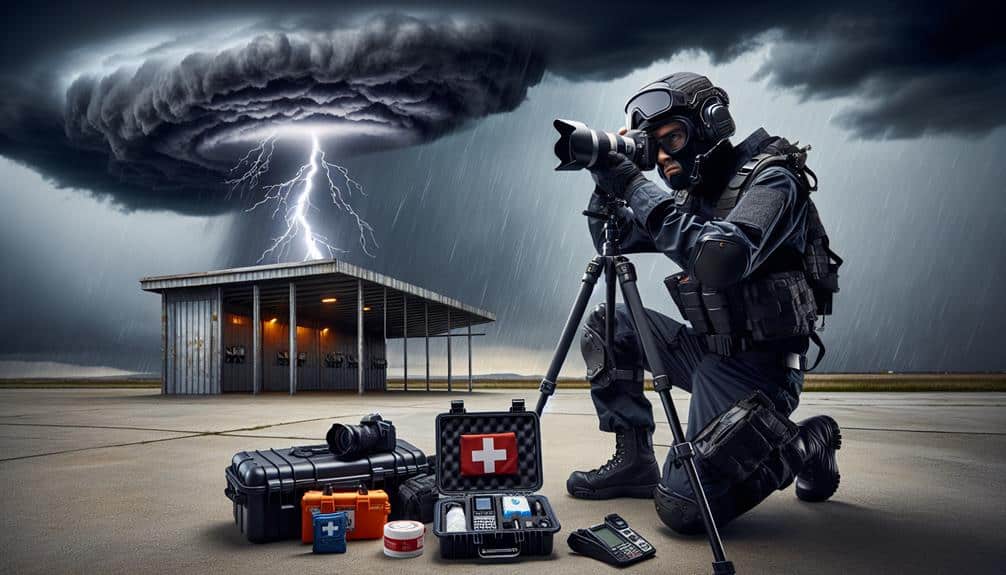
Before heading out to photograph lightning, we must assess the weather conditions and have a clear safety plan in place. Knowing what to do before, during, and after a storm is essential.
An effective emergency response strategy can greatly increase our chances of staying safe. Implementing thorough safety precautions not only helps us capture stunning images but also ensures we don't endanger ourselves in the process.
Here's a streamlined, data-driven emergency preparedness plan:
- Weather Monitoring: Utilize reliable meteorological data sources like NOAA or the National Weather Service. Real-time updates allow us to make informed decisions.
- Communication Devices: Equip ourselves with fully charged mobile phones and portable radios. These are vital for emergency communication when standard networks fail.
- Shelter Identification: Before setting up, identify nearby safe zones such as cars or buildings. Lightning tends to strike the highest point, so avoiding open fields and isolated trees is crucial.
- First Aid Kit: Carry a complete first aid kit. Immediate medical response can mitigate the effects of lightning strikes or other injuries.
Frequently Asked Questions
What Camera Settings Should I Use to Capture Lightning Strikes Effectively?
To capture lightning strikes effectively, we should set long exposure settings, around 10-30 seconds. Proper composition and focusing on the sky are important. Timing is essential; use a remote trigger or intervalometer for best results.
Can I Photograph Lightning Strikes With a Smartphone?
When photographing lightning strikes, smartphones are often limited in capturing precise details. We should consider safety precautions and alternative equipment. Experienced photographers might use DSLRs or mirrorless cameras, ensuring better results and enhanced safety.
How Do I Post-Process Lightning Photos for Maximum Impact?
For maximum impact in lightning photography, let's apply advanced editing techniques like contrast adjustment and noise reduction. Focus on composition tips: emphasize leading lines and symmetry. These methods amplify the dramatic effect, ensuring striking, compelling images.
What Are the Best Times of Year to Photograph Lightning?
We live for those electrifying moments! Peak lightning times are during summer storms, typically between late afternoon and evening. Data shows lightning activity spikes in July and August, offering unparalleled opportunities to capture nature's raw power.
How Can I Predict Lightning Strikes Without Professional Equipment?
We can predict lightning strikes by monitoring cloud patterns and changes in atmospheric pressure. Lightning safety is paramount; observe cumulonimbus cloud formations and listen for distant thunder. Reliable apps and weather websites are also excellent resources.
